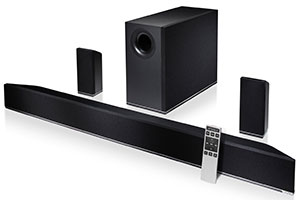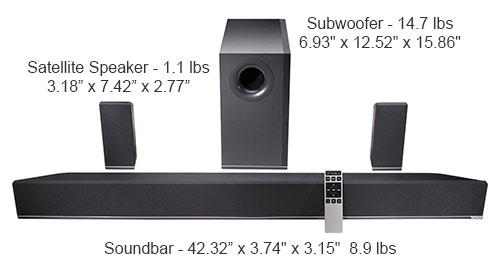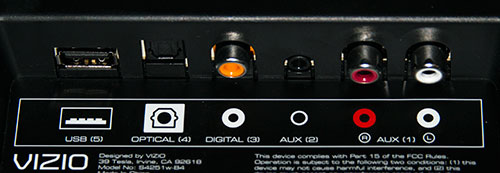
|
|
 |

|


|
VIZIO S4251w Review
42-inch Bluetooth Enabled 5.1 Sound Bar System, $329

Dick De Jong Introduction
In almost every review of a TV - even the most expensive ones - I state that if you want to do justice to the TV's picture quality, you need to invest in a dedicated audio system. Almost all the tiny, low powered speakers that are integrated into TVs these days are simply not up to the task. If you are building a full-blown home theater, then you are probably shopping for a strapping surround sound system with at least 5, 7, or even 9 speakers and a subwoofer (or two), all powered by an AV receiver. For those with tighter budgets and less grand visions, a sound bar system like the VIZIO S4251w can more than fulfill your audio needs. Indeed, this VIZIO 5.1 system with its three channel sound bar, two surround satellite speakers, and chest-rattling subwoofer, delivers a full bodied, high fidelity sound that can easily fill a large TV room. With a rated output of up to 102dB, the S4251w can definitely shake, shake, shake your tail feathers. Even though sound bars have traditionally served solely as an auxiliary audio system for TVs, in today's mobile world, we want them to playback our music from our smartphones, tablets and phablets. 
With Bluetooth capabilities, VIZIO S4251w effortlessly connects to all your Bluetooth devices. In fact, it took me about 30 seconds to pair my iPad with this sound bar, allowing wireless playback of music from this tablet. I also paired my Bluetooth enabled computer and Android smartphone. Oh, what a wonderful interwoven world we live in. Out of the Box
The VIZIO S4251w box is efficiently but uniquely shaped and at 33 pounds, not the easiest to manhandle. Take note of the suggestion for opening.  Inside, VIZIO supplies the sound bar, the subwoofer, and the two satellite speakers and in a magnanimous gesture, every possible cable that you might need to connect to your audio sources, including an optical digital audio cable. Unless you have an odd duck piece of equipment, you should be ready to plug and play.  The back and sides of the sound bar are housed in a matte black plastic. The front is primarily covered with black speaker grille mesh except at the bottom where a line of indicator lights are topped by a silver accent strip. The subwoofer and satellite speakers echo that same matte black and silver accent motif. On the left side of the sound bar are five operational buttons. On the back is the audio connection panel, which includes one Optical Digital Audio In (S/PDIF), one Coaxial Digital Audio In (S/PDIF), one Analog Audio In (3.5mm stereo mini-jack), one Analog Audio In (stereo RCA), and one USB port (for firmware updates downloaded from your computer on to a USB flash drive).  Inside the sound bar enclosure, the Left and Right Channels each consist of a 3/4-inch tweeter and two 3-inch mid-range drivers. The Center Channel is composed of two 2.5-inch full-range drivers. The beast of a subwoofer contains one 6-inch long throw (high excursion) driver. The subwoofer communicates to the sound bar wirelessly, within a 60-foot range. It still needs to be plugged in to a wall outlet for power. The satellite speakers are not wireless. They connect to the subwoofer with separate 13-foot audio cables which also supply them with power. 
The compact (1.62" x 5.5"), non-backlit, brushed silver remote control provides a feature not often found on sound bar remotes, a little LCD display that shows the menu options and their status. Normally, with remotes that don't have LCD displays, you must rely on the little indicator lights on the sound bar to guide you. With the S4251w's remote, you can punch the Input button and see on the display which Input is currently selected. And if you wish to switch to another Input, your choice is displayed in the little window. The LCD display is not the easiest one to read. I needed to adjust the remote to get the right viewing angle. But if you have ever tried to decipher from across the room what those indicator lights on the sound bar were trying to tell you, you will count your blessings for this remote's display. It's not just Inputs that you can pick with the remote. The sound bar menu includes settings for features like Bluetooth Pairing, Eco Power, Subwoofer, Surround Balance, and TruVolume. Occasionally, you will have to peer at those sound bar indicator lights as you are adjusting items like Volume, because the LCD display does not show the volume level. Setup
The first step in setting up your sound bar system is deciding where to locate all of the speakers, which may seem simple but can be a little tricky. For example, the long sound bar should be centered under the TV. But if your TV is sitting on a table, you may have a bit of a logistical situation in placing the sound bar. If you set this almost 4-inch high sound bar on the same table, it may block the bottom part of the TV screen. Even if the screen clears the sound bar, the TV's IR window that receives the TV's remote control signals may be blocked. Even with a 55-inch TV, if its stand does not raise the screen high enough, the remote may not communicate with the TV. One solution is to mount the sound bar - even if the TV is not wall mounted. VIZIO supplies two wall mount brackets (with screws) and a mounting template for the sound bar. The box also includes wall mount brackets for the two satellite speakers. Of course, if you mount the TV on the wall, then affixing the sound bar below it should be no problem.  Your next task is to decide how you will feed audio to the sound bar. Many newer TVs support a feature called ARC (Audio Return Channel), which sends the audio coming into the TV out an HDMI cable. Some sound bars will offer at least one HDMI input. The VIZIO S4251w does not provide an HDMI input. That being the case, I prefer the digital optical method of routing the audio from the TV to the sound bar. The VIZIO S4251w supplies two digital connections, one coaxial and one optical. The problem is that not all TVs have either of these connections. If your TV does not and you want to stay in the digital audio realm, then you will need to attach the sound bar directly to your system's digital audio sources like a set top box or a Blu-ray player. If instead you want to only connect to your TV, most of them have either a headphone jack or a pair of RCA analog audio outs that you can plug into one of the analog audio options on the sound bar. If you have multiple devices that you want direct access to, the VIZIO S4251w provides two digital and two analog inputs that you can switch between with the remote control. 
The S4251w sound bar does decode DTS Master audio signals, which is a high-end audio format often used in Blu-ray movies. It also handles Dolby Digital, DTS TruVolume and DTS CircleSurround. As for Bluetooth, I found pairing the sound bar to my iPad to be quick and painless. If you are a Bluetooth novice, the process is straightforward, though you may need to refer to both the sound bar and the device's instruction manuals on how to initiate the pairing. The recommended range for streaming between Bluetooth devices is within 30 feet. Performance
VIZIO in the specifications for its S4251w sound bar does not rate the power of the system, but without a doubt, the 5.1 speaker system definitely can flex its muscles and fill a good sized room with plenty of volume. In our 200 square foot office, I couldn't push it much beyond half without incurring structural damage. I imagine that a room twice this size still could not contain full volume. If I have one niggle with the S4251w, it's the Volume control. Unlike the graduated control you get with a Volume knob on an AV receiver, to adjust the volume on this sound bar, you push the + or - buttons on the remote and the sound steps up or down. To my ears, as I was adjusting the volume, there was always a time where just one push of the + button jumped the volume from loud to way too loud. It seemed to be skipping past an in-between level. It's a minor thing. But as visceral as pounding your ear drums can be, the real factor in judging any speaker system is audio quality. My first impression of the S4251w is that it tends to be bright, which is not necessarily a bad thing, though I usually prefer a sound that's a little flatter. After listening to a variety of different sound sources, I changed my description to "lively," which again is not a bad thing and in fact, I found that the S4251w was responsive to the characteristics of the music or soundtrack that it was reproducing. If you like to tweak, VIZIO does provide basic audio adjustments to Treble, Bass, Center and Surround levels. Now, I'm not suggesting that the S4251w can compare to those sublime speaker systems that seem to massage your ear canals. Then again, this VIZIO sound bar system costs a fraction of those premium speakers. I will state that the S4251w with its subwoofer and satellite speakers is certainly an major upgrade to the audio emanating from the underpowered speakers integrated into today's TVs. Value
The sound bar market has become very crowded in the last couple of years. And even though you can find sound bars for twice the price, the $329 price tag for the VIZIO S4251w puts the system in the midst of some stiff competition. But considering that the powerful S4251w is a full 5.1 system with Bluetooth and a remote with a handy LCD display, I believe that its performance offers a real value.  Conclusion
The 42-inch VIZIO S4251w sound bar system produces room-filling, full bodied surround sound, making it a great complement to a large TV. And with Bluetooth capabilities, this 5.1 sound bar unit also serves as a perfect wireless music streaming companion to your mobile devices. |
Bookmark:
![]() del.icio.us
del.icio.us
![]() Reddit
Reddit
![]() Google
Google
Reader Comments
Posted Dec 30, 2014 5:32:05 PM |
|
By Dick De Jong |
|
You already have identified the problem. Simply, not all TV stations broadcast a surround sound (5.1 channel) signal. Therefore, with those TV stations, the back surround speakers will be silent.
Actually, in many cases, it's not the local TV station but the network that might not always broadcast a 5.1 signal.
There is nothing wrong with the speakers, they just are not receiving a signal.You might be able to recreate a surround effect if you are running your audio through an AV receiver that can take a non-surround signal and process it into a 5.1 surround effect. Otherwise, you just have to accept that occasionally there will be no output from the back speakers.
Posted Dec 27, 2014 5:07:53 PM |
|
By Rhonda |
|
| Send this Page | Print this Page | Report Errors |


Posted Nov 15, 2015 7:33:31 AM
By Al Gee
Thank you for your review, found it very informative.